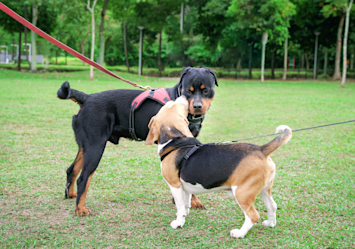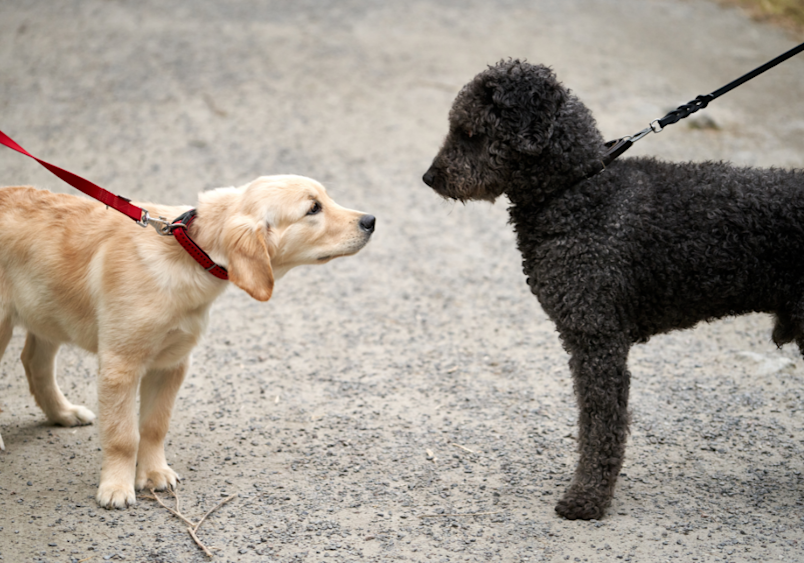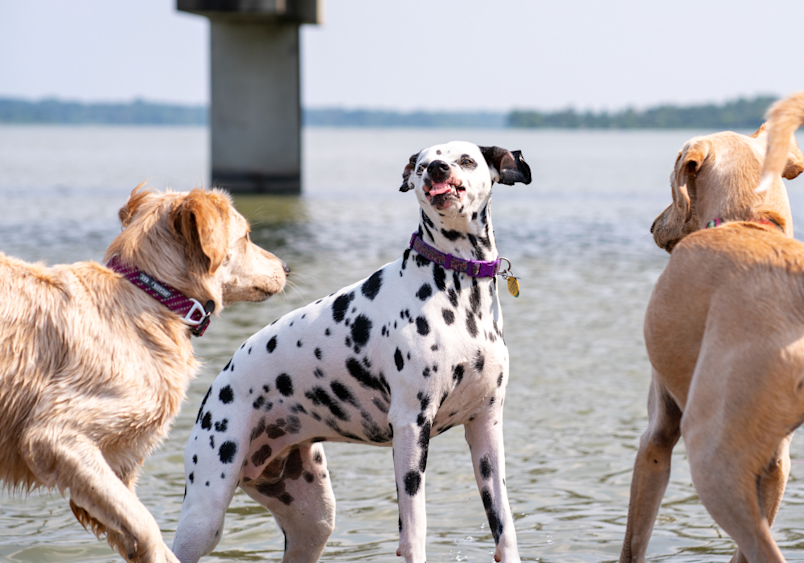
Does your dog hide when guests arrive? Do they bark uncontrollably at other dogs on walks? You're not alone—many pet parents struggle with dog socialization, but the good news is that it's never too late to help your furry friend feel more at ease. Whether you have a playful puppy, a cautious adult dog, or a senior companion, this guide will walk you through how to socialize a dog with patience, positivity, and proven techniques.
Socialization isn't just about teaching manners—it's about building your dog's confidence and ensuring their emotional well-being. A well-socialized dog is happier, healthier, and safer in unpredictable situations.
Understanding Dog Socialization
Dog socialization is the process of exposing your dog to new experiences—people, animals, environments, and sounds—in a way that fosters positive associations. There are many types of dog socialization, including with people, children, fellow dogs, or other animals. The goal is to help your dog feel confident and relaxed in different situations, reducing fear, anxiety, and potential behavioral problems.
Why Dog Socialization Matters
Proper socialization helps prevent fearful reactions and aggression while promoting confidence and adaptability. A well-socialized dog:
Feels more comfortable in new environments
Exhibits fewer behavioral problems
Interacts more positively with people and other animals
Experiences less stress and anxiety during routine activities
Adapts more easily to changes in their environment
Without socialization, dogs may develop fears or phobias that can lead to defensive behaviors, making everyday situations stressful for both you and your pet.
How to Socialize Your Puppy and Why It's Important
Puppies have a critical socialization period between 3 and 16 weeks of age when they're most receptive to new experiences. During this window, positive exposures create lasting impressions that help shape your puppy's future behavior and temperament. Puppies are like sponges during their first few months. Here’s how to make the most of this formative period:
The Puppy Socialization Timeline
3-12 weeks: Prime socialization period when puppies are naturally curious and less fearful
12-16 weeks: Still receptive but becoming more cautious
16+ weeks: Requires more patience as puppies become more set in their responses
Effective Puppy Socialization Techniques
Start with gentle exposures: Introduce your puppy to different people, including children, men with beards, and people of various appearances.
Introduce various environments: Visit parks, pet-friendly stores, and quiet streets without overwhelming them.
Expose to different sounds and textures: Familiarize them with household appliances, various walking surfaces, and common sounds.
Arrange puppy playdates: Once your puppy has received appropriate vaccinations, arrange controlled meetings with well-socialized dogs.
Attend puppy classes: Professional puppy socialization classes provide structured environments for your pup’s learning social skills. These classes often incorporate basic obedience training, which you can reinforce at home by teaching essential commands that help your puppy navigate social situations with confidence.
Keep all experiences positive and never force your puppy into uncomfortable situations. Use treats, praise, and play to create positive associations.

How to Socialize an Adult Dog
While adult dogs may take longer to adapt, progress is definitely possible. Many adult dogs missed their optimal socialization window or had negative experiences that affected their social comfort level. But with patience and consistency, you can help them build confidence and trust.
Socialization Strategies for Adult Dogs
Respect Their Comfort Zone: Never force your dog into an interaction that makes them uncomfortable. Allow them to explore at their own pace to build confidence.
Identify Triggers: Observe what makes your dog fearful—is it men, loud noises, or other dogs? Recognizing specific triggers is the first step in helping them overcome fears.
Create Positive Associations: Use high-value treats or rewards during new experiences. Find what motivates your dog—cheese, chicken, or a special toy—to create positive connections.
Start in Calm Environments: Give your dog a controlled setting where they can adjust gradually. Some dogs may need time to observe and acclimate before feeling comfortable enough to interact.
Practice Gradual Exposure: Use everyday situations to introduce positive social interactions. The more opportunities your dog has to experience new people, places, and things in a safe, positive way, the more their confidence will grow.
Choose Suitable Locations: Visit peaceful parks or less crowded trails where your dog can practice social skills without feeling overwhelmed.
Set Up Controlled Meetings: Arrange introductions with calm, dog-savvy friends in neutral environments to build positive experiences.
With patience, consistency, and this structured approach, even if your dog missed early socialization, they could learn to navigate the world with confidence.
How to Socialize Your Dog with Other Dogs
Just like not all people get along, not all dogs do either. Your dog doesn't need to love every dog they meet; they just need to be socialized enough to be reasonable and safe around other dogs.
Steps for Dog-to-Dog Socialization
Understand Your Dog's Preferences: Pay attention to which dogs your pet feels comfortable around. Your dog might prefer a specific size, energy level, or even gender of playmate.
Match Temperaments Wisely: Your shy dog will likely do better with a calm, older dog than an energetic puppy. Matching compatible personalities sets everyone up for success and builds your dog's confidence.
Choose Neutral Territory: Always introduce dogs on neutral ground—a quiet park or walking path where neither dog feels the need to defend "their turf." The proper technique for these first meetings is crucial for building positive relationships—learning how to safely introduce dogs can prevent negative experiences that might set back your socialization efforts.
Try Parallel Walking: Walk dogs side by side with space between them, gradually decreasing distance as comfort grows. This allows your dog to become familiar with another dog's presence without the pressure of direct interaction.
Watch Body Language Closely: Your dog is constantly communicating through body signals. Learn to recognize comfort signals (relaxed movements, play bows) versus stress signals (lip licking, stiff posture, whale eyes).
Keep Initial Meetings Brief: Set your dog up for success with short, positive interactions. A quick 10-minute playdate that ends on a happy note builds more confidence than an hour-long session where your dog becomes overwhelmed.
End on a Positive Note: Be ready to calmly separate dogs at the first sign of tension, always finishing before either becomes stressed.
Seek Professional Help When Needed: If your dog shows signs of aggression or intense fear around other dogs, don't hesitate to consult a positive reinforcement trainer.
How to Socialize an Older Dog: Is It Too Late to Socialize My Dog?
Socializing an older dog requires patience and realistic expectations. While progress may be slower, you can help your senior dog become more comfortable in social situations.
Tips for Socializing Senior Dogs
Create a Comfort Zone: Your older dog needs a safe space to retreat to when things get overwhelming. Set up a cozy bed in a quiet corner where they can observe interactions without pressure, and keep their environment manageable with exposure to just a few people or animals at a time.
Respect Their Energy Levels: Your senior companion tires more easily than younger dogs. Keep socialization sessions brief—even 5-10 minutes can be plenty. Watch for signs of fatigue like panting, slowing down, or seeking a place to lie down, and end sessions before exhaustion sets in.
Rule Out Health Issues: Before assuming your older dog is just "unsocial," schedule a vet check to rule out pain or illness that might be affecting their behavior. Arthritis or hearing loss can make your dog seem grumpy when they're actually uncomfortable.
Be Their Confident Advocate: Your dog looks to you for reassurance. When introducing your senior to new situations, stay calm and relaxed rather than feeding into their fears. Your confidence signals to your dog that there's no danger, helping them feel secure.
Celebrate Small Victories: For your older dog, simply being in the same room with a stranger without showing signs of distress might be a significant achievement. Set realistic goals and celebrate these small wins—they're actually huge steps for your senior pet.
Keep a Consistent Schedule: Your older dog benefits from predictable routines. Make sure that dog socialization does not interrupt normal meal or nap times.
How to Socialize Your Dog with Humans
Building positive associations between your dog and humans of all ages is essential for a well-adjusted pet. Whether your dog is naturally shy or has had limited exposure to different types of people, these techniques can help:
Effective Human Socialization Techniques
Start with Dog-Friendly People: Introduce your dog first to calm, patient people who understand and respect canine body language. Your dog will pick up on their relaxed energy and feel more at ease.
Use Food as a Social Currency: Have new people offer your dog's favorite treats with an open palm, avoiding sudden movements or direct eye contact initially. Nothing says "nice to meet you" to your dog like a tasty reward!
Respect Your Dog's Comfort Zone: Allow your dog to observe humans from a comfortable distance before encouraging closer interaction. Never force your dog to accept petting when they're showing signs of fear—this common mistake can create lasting negative associations.
Introduce Different Types of People: Gradually help your dog meet people of various ages, heights, and appearances. Children move differently than adults, and someone using a cane or wheelchair might initially confuse your dog—controlled exposure helps them learn that different doesn't mean dangerous.
Practice Handling for Veterinary Visits: Gently touch your dog's paws, ears, and mouth at home, immediately following with treats and praise. These handling exercises prepare your dog for grooming sessions and vet appointments, reducing stress during necessary care.
Set Up Guest Guidelines: When visitors come over, ask them to ignore your dog completely at first. This counterintuitive approach removes pressure and allows your dog to investigate newcomers on their own terms when they feel ready.
Remember, your dog's trust in humans develops through consistently positive experiences. Each successful interaction builds confidence for the next one, creating a positive cycle that transforms even shy dogs into social butterflies.

Addressing Behavioral Challenges in Dogs
Most dogs aren't actually aggressive; rather, they show aggression when exposed to certain triggers. Some dogs have unhealthy prey drive, while others display resource guarding behaviors such as food aggression, where they defensively protect items, they consider valuable. Some behaviors are commonly associated with certain breeds, and it can be harder to unlearn if it's what the dog was bred for. However, that doesn't mean anti-social or aggressive behavior should be tolerated.
Managing Reactivity and Aggression
Identify Triggers: Once you know what causes reactions, manage environments to keep everyone safe. For example, a food-aggressive dog should only enjoy special treats in private spaces.
Provide Exercise: Ensure sufficient physical and mental stimulation, perhaps during quieter times to minimize trigger exposure.
Avoid Punishment: Never punish fear-based behaviors—this only reinforces negative associations. Consult a positive reinforcement trainer for professional guidance.
Build Basic Skills: Focus on obedience training to increase confidence and provide helpful commands during challenging situations.
Set Realistic Goals: Progressive improvement rather than perfection should be the aim. Small achievements matter.
Protecting Your Pet Through Socialization and Beyond
As you invest time and patience in your dog's socialization, consider protecting their health for the journey ahead. Even the most carefully socialized dogs may encounter unexpected situations—a nervous dog might bolt and sustain an injury, or anxiety from new experiences could manifest as digestive issues. These moments are precisely when having pet insurance becomes invaluable.
Quality protection for vet bills provides a safety net as your dog explores new environments, whether they’re a cautious senior learning to navigate social settings or an enthusiastic puppy meeting the world for the first time. On top of that, an optional, non-insurance wellness plan can complement this coverage by helping you budget for preventative care, including professional training sessions that enhance your socialization efforts. When you can make decisions based on what's best for your dog's wellbeing rather than financial constraints, you'll find yourself more confident in creating those positive social experiences that build your dog's trust and adaptability for life.
A Lifelong Journey of Social Growth
Your dog's socialization journey isn't a race or a checklist but rather a lifelong path of growth and connection. Whether you're guiding a puppy through their critical early weeks, helping an adult dog overcome past fears, or gently expanding your senior dog's comfort zone, the fundamental principle remains the same: let your dog set the pace. Techniques like creating positive associations, reading body language, managing environments, and celebrating small victories all work together to build your dog's confidence in navigating our complex human world.
The investment you make in socializing your dog yields returns far beyond basic obedience or good manners. A well-socialized dog experiences less stress at the vet, adapts more easily to life changes, and forms deeper bonds with family members. By understanding your dog's unique preferences and respecting their boundaries while gradually expanding their experiences, you're not just preventing behavioral problems—you're enriching their life and yours. Every positive interaction becomes a building block in your dog's social development, transforming even the most hesitant canine into a confident companion who brings joy to everyone they meet.